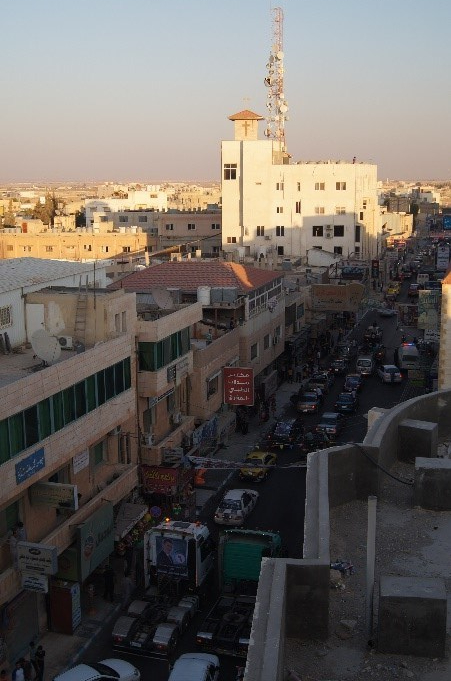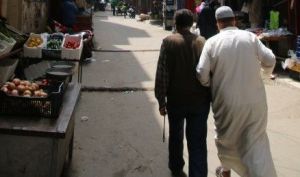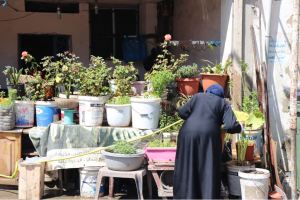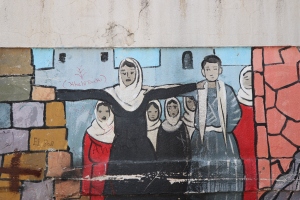The Southern Responses to Displacement project is examining different discourses and ideological frameworks used to justify certain responses to displacement, including local and transnational faith-based responses in and from the global South. In this piece, Ann Christin Wagner draws on her ethnographic fieldwork on faith-based responses providing support to communities displaced from Syria and living in Mafraq, Jordan. The Mafraq Unity Church, despite being an offshoot of American Evangelical denomination and utilising the ‘localisation of aid’ agenda and international ‘development script’ to secure funding, relies heavily on both spiritual and financial networks from the Global South, including Asian countries such as Malaysia and Thailand. Wagner demonstrates the importance of these networks and resources in terms of how and where aid is distributed, and by whom, and how they strengthen the church and its programs within the community. Through these insights Wagner critically analyses the power relations that underpin faith-based humanitarian responses, addressing important questions about what is motivating, shaping and promoting humanitarian action in the global South.
This blog was posted on 14th of January 2019
If you find this piece of interest, please also see the suggested readings at the end of this piece, or visit our introductory mini blog series, here.
“There are no missionaries here!” – how a local church took the lead in the refugee response in northern Jordan
By Ann-Christin Wagner, PhD candidate, University of Edinburgh
Mafraq, a Jordanian provincial town within hearing range of the bombings in Daraa in southwestern Syria, is home to circa 100,000 locals and a similar numbers of Syrians, making it one of the cities most affected by the mass displacement of refugees from Syria in the Middle East. Mafraq’s native and refugee population are almost exclusively Muslim.
One of the town’s small Christian communities is the Mafraq Unity Church.[1] An offshoot of an American Evangelical denomination, it is composed of only 120 locals and foreigners. And yet, its brand-new church building is one of the tallest structures on Mafraq’s high street, its tower adorned by a human-sized cross that looms over the roofs. At street level, the entrance to the church is easily recognizable because of the groups of veiled Syrian women, dressed in black abayas, who wait by the door for aid every day.
The church’s new visibility in Mafraq’s urban landscape has to be understood in the context of its pioneering role in the local response to refugees since 2011. In this blog post, I draw on a series of interviews that I conducted with the pastor of the Mafraq Unity Church in 2015-16 when I conducted ethnographic fieldwork for my doctoral thesis in the area. During this time, I came to know the church in various capacities: as a volunteer with a grassroots organisation that had strong ties with the church, as a research student, and as a member of their parish. My position at the intersection of academic research, faith-based and secular humanitarianism mimics the overlapping networks that the church so aptly navigates, an issue which I will discuss in more detail below.
In what follows, I try to explain how a small indigenous church in a majority-Muslim town turned into one of the most prominent local aid providers for Syrian refugees. I argue that diverse transnational connections keep the Unity Church’s humanitarian operations going, obliging it to balance acts of self-representation with the policies of disparate partners: European governments, international aid agencies, but also fellow Evangelicals and faith-based organisations.
In every interview, the pastor was quick to point out that, despite its manifold humanitarian activities, the community was still “a church, not an NGO!” However, the pastor’s office inside the church conveyed a different message. One wall was dominated by a huge whiteboard with the visiting schedule of the church’s various short-term volunteers and international partners. With a sweeping gesture, the pastor invited visitors to check his bookkeeping and his workplace: “Everything we receive, we share it… My computer is always open, even my email.”
We might not expect accounting and human resources management to be among a church’s priorities. However, church officials quickly learned the jargon and practices of mainstream humanitarian action when Syrians started coming to Mafraq in 2011. While international aid organizations were initially slow to follow – the local UNHCR office only opened in 2014 – the church was among the first to provide emergency aid. Despite its tiny congregation, by the end of 2016, it had assisted almost 50% of the refugees in town. Every month, it provided food parcels to 400-500 Syrian families. Later, the church launched its own development programmes, including an informal school, medical aid and educational trainings for adults.
The church did not only “do” development: its officials also “spoke” development jargon, and the pastor aptly turned the church’s “localness” into a selling point. It was presented as more cost-efficient and with greater accountability: “Without the locals, relief would be wasted.” The pastor noted that providing humanitarian assistance in the Middle East was seen by many as being preferable to refugees’ onward flight to Europe: “We are a small country. But having one million Syrians [in Jordan] is [seen as being] better than in Germany. They cost less [to European countries].”
Not only was the pastor well aware of the international community’s ‘localization of aid’ agenda, but also of increasingly hostile asylum policies in Europe. Hence, he suggested a trade-off to potential donors: if the church received further funding, it would continue caring for Syrian refugees – and thus provide incentives for them to stay in Mafraq.[2] In this way, it successfully procured donations from European governments and NGOs. Its activities, management style and fundraising strategy situated the church on the playing field of the “international community” of humanitarian action.
On Sundays, however, I witnessed a different community inside the church’s makeshift nave in the half-finished building. By the end of 2016, the church employed approximately 20 members of its own congregation, in addition to forty short- and long-term volunteers from fellow Evangelical congregations from all over the world. On average, it welcomed one to three teams of up to 40 foreigners every week. The bilingual Sunday service celebrated their cosmopolitan Evangelical community. It always began with singing in English and Arabic, followed by greetings to incoming groups: “Jordanians, Palestinians, Indians, one church!” One by one, newcomers were called up by name and place of origin and introduced to the parish: “Welcome to those who bring us greetings from Washington, DC!”
As becomes clear from volunteers’ diverse places of origin, the transnational dimension of Evangelism made the strength of the Unity Church. However, the church relied on different economic and spiritual geographies of faith. On the one hand, it received financial support and volunteers mostly from Europe and North America. For example, by the time of my fieldwork, its American mother congregation had just paid for a pick-up truck, land and a house for its new school building.
On the other hand, the pastor turned to the Global South for spiritual matters. He was adamant about asserting Jordanian ownership of the church and liked to tell the story of its modest beginnings in a traditional mud house – the church was materially made of the native earth of Mafraq.
Established in 1948 by a Syrian whose offspring went on to found churches in Aleppo and Damascus, the church’s first converts were local Greek-Orthodox Christians. I also learned that the pastor’s tribesmen had migrated only a few generations ago from a Syrian village just across today’s border. While the church’s original ground was purchased by its American mother congregation, the pastor emphasized that the church had long been run by locals: “There have been no missionaries here for the last fifty years. We are independent!”
However, this was not entirely true: in 1965, an American doctor had founded a well-known sanatorium for chest diseases to deliver medical services, but also the gospel, to Bedouins in the area, and foreign medical staff from the sanatorium were a regular presence at church services. But by emphasizing Arab networks rather than transatlantic connections, the pastor subtly shifted the centre of gravity of Evangelical Christianity away from the US.
Through his networks, the pastor also had a clear idea about where today’s Christians could be found. During my fieldwork, he frequently attended Evangelical conferences abroad – quite tellingly, most of them in Asian countries like Malaysia and Thailand. His spiritual geography, centered on the Arab world and on Asia, reflects the spatial distribution of Christians today, 61% of whom live in the Global South (Pew Research Center 2011). It also resonates with wider tendencies in Evangelical mission towards the indigenization of southern churches (Hutchinson and Wolffe 2012).
However, the pastor’s aim was to re-centre Christianity not only to the Global South, but to Mafraq in particular. He explained to me that “[Jordan] was a Christian country. In Rihab, in the west [of Mafraq], there are more than fifty churches.” Hinting at the recent discovery of an ancient underground church – possibly the oldest church in the world – in nearby Rihab, the pastor’s account of Christian history symbolically expanded the Holy Land of the Bible eastwards beyond the Jordan River, so that it came to include Mafraq.[3] From the pastor’s perspective, providing aid in Mafraq was thus at the heart of Christianity.
In sum, my ethnography of the Mafraq Unity Church corroborates existing research on faith-based humanitarianism about the importance of religious networks and resources. Faith makes a difference to how (and by whom) aid is financed, organised and delivered. My case study also adds another chapter to the history of American mission in the Arab world. Far from being reducible to “a [subdued] minority or […] an extension of Western Civilization” (Rowe 2010: 472), the members of the Mafraq Unity Church show a considerable degree of agency in navigating secular and non-secular transnational connections.
Critics of the aid industry’s turn towards the local bemoan that devolving responsibility to southern actors might justify funding cuts. Yet Jordanian Christians, although far from being development professionals, strategically engage with secular funders’ priorities, by learning how to speak managerial and localized “development script”.
My study also reveals conceptual limitations of the localization agenda: The Mafraq Unity Church is hardly representative of the town’s inhabitants. As it has turned itself into a crossroads of flows of Evangelical humanitarians, material aid and money, it is impossible to know what purely “local” aid provision would look like.
An extended version of this blog post won the Council for British Research in the Levant’s 2018 Best Paper Award and was published in Contemporary Levant in October 2018.
**
Hutchinson, M. and Wolffe, J. 2012. A short history of global Evangelicalism. Cambridge: Cambridge University Press.
Katz Kimberly. 2003. Legitimizing Jordan as the Holy Land: Papal Pilgrimages. 1964, 2000. Comparative Studies of South Asia, Africa and the Middle East, 23 (1&2), 181-189.
Pew Research Center, 2011. Global Christianity. A report on the size and distribution of the world’s Christian population. The Pew Forum on Religion and Public Life. Available from: http://www.pewforum.org/2011/12/19/global-christianityexec/
Rowe, Paul S. 2010. The Middle Eastern Christian as Agent. International Journal of Middle East Studies, 42(3), 472-474.
**
[1] To protect my informants, the name of the church was changed.
[2] The pastor’s rhetorical strategy reflects Jordanian raison d’État – in an interview with the BBC in 2016, King Abdullah of Jordan threatened that “the damn [was] going to burst” if the international community did not step up its support for Syria’s neighbouring countries.
[3] Pastor Aissa’s appraisal of Mafraq’s centrality to Christian heritage and territory also resonated with the Jordanian national project of branding the country as the original “Holy Land” through archaeology and religious tourism (Katz 2003).
Recommended Reading:
Responses to displacement led by actors across the global South are widespread and also highly diverse, including different forms of faith-based responses. To read more about the roles of religion in motivating, shaping, and promoting humanitarian action in the global South, visit our Faith-based humanitarianism page, and read these posts by the Southern Responses team:
Carpi, E. (2018) ‘Does Faith-Based Provision Always Localise Aid?’ (originally posted on Refugee Hosts)
Carpi, E. (2017) ‘Localising Response to Humanitarian Need’
Kidwai, S. and Fiddian-Qasmiyeh, E. (2017) Seeking Evidence to Provide Protection: How can local faith communities support refugees? Refugee Hosts
Fiddian-Qasmiyeh, E. and Qasmiyeh, Y.M. (2017) ‘Refugee-Refugee Solidarity in Death and Dying,’ Refugee Hosts
Fiddian-Qasmiyeh, E. (ed) (2016) Gender, Religion and Humanitarian Responses to Refugees, MRU Policy Brief.
Refugee Hosts (2018) Local Faith Community Responses to Displacement in Lebanon, Jordan and Turkey: Emerging Evidence and New Approaches. Refugee Hosts report authored by Greatrick, A., Fiddian-Qasmiyeh, E., Ager, A., Rowlands, A. and Stonebridge, L.
Featured image: Christian symbolism, Jordan. (c) Ann-Christin Wagner, 2018



